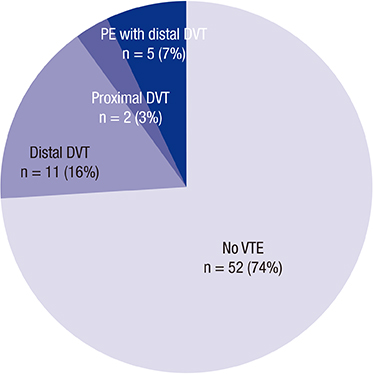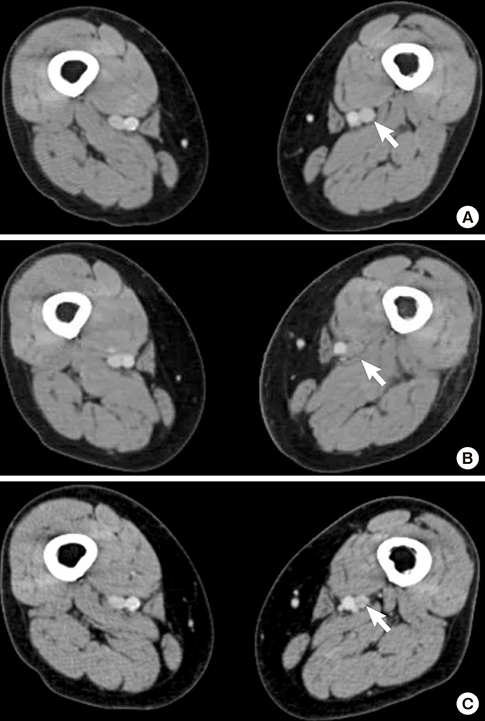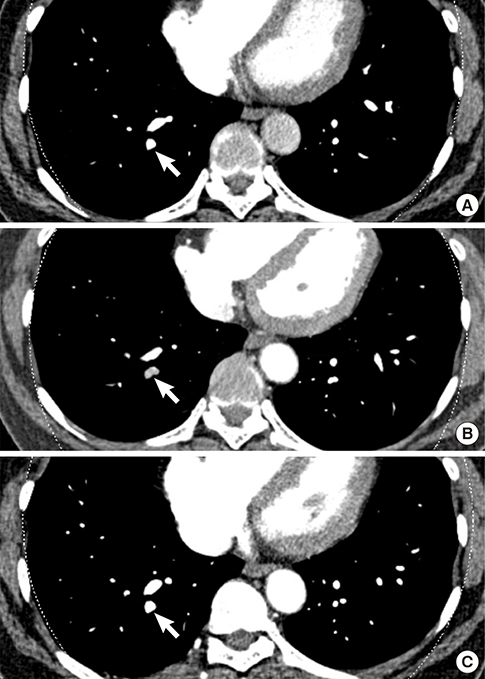J Korean Med Sci.
2016 Mar;31(3):443-448. 10.3346/jkms.2016.31.3.443.
Is Routine Thromboprophylaxis Needed in Korean Patients Undergoing Unicompartmental Knee Arthroplasty?
- Affiliations
-
- 1Department of Orthopaedic Surgery, The Catholic University of Korea, Seoul St. Mary's Hospital, Seoul, Korea. iy1000@catholic.ac.kr
- 2Department of Orthopaedic Surgery, The Catholic University of Korea College of Medicine, Seoul, Korea.
- 3Gangseo Himchan Hospital, Seoul, Korea.
- KMID: 2363507
- DOI: http://doi.org/10.3346/jkms.2016.31.3.443
Abstract
- This study was undertaken to determine the prevalence and the natural course of venous thromboembolism (VTE) without thromboprophylaxis to ascertain whether routine thromboprophylaxis is necessary following unicompartmental knee arthroplasty (UKA) in Korean patients. The medical records and multidetector row computed tomography (MDCT) imaging of the consecutive 77 UKAs in 70 patients were reviewed. In all patients, MDCTs were undertaken preoperatively and at 1-week after surgery, and VTE symptoms were evaluated. At postoperative 6-months, follow-up MDCTs were undertaken in all patients in whom VTEs were newly detected after surgery. VTE lesions were newly detected in 18 (26%) of the 70 patients. However, none of the patients complained of VTE-related symptoms and MDCT demonstrated that all VTEs were small and involved limited portion without lower leg edema or pleuroparenchymal complication. At the 6-month follow up MDCT, all types of VTEs were shown to be completely resolved, regardless of their location. All of the VTE lesions maintained an asymptomatic status for 6-month after surgery. VTE following UKA in Korean patients who do not receive thromboprophylaxis seems to occur frequently, but all of the VTEs are clinically insignificant and all VTEs are spontaneously regressed. Routine thromboprophylaxis or thrombolytic treatment in Korean patients undergoing UKA may not be necessary.
Keyword
MeSH Terms
-
Aged
*Arthroplasty, Replacement, Knee
Asian Continental Ancestry Group
Female
Fibrinolytic Agents/therapeutic use
Humans
Knee/diagnostic imaging
Male
Middle Aged
Postoperative Complications
Republic of Korea
Retrospective Studies
Risk Factors
Tomography, X-Ray Computed
Venous Thromboembolism/diagnostic imaging/*prevention & control
Fibrinolytic Agents
Figure
Reference
-
1. Falck-Ytter Y, Francis CW, Johanson NA, Curley C, Dahl OE, Schulman S, Ortel TL, Pauker SG, Colwell CW Jr. American College of Chest Physicians. Prevention of VTE in orthopedic surgery patients: Antithrombotic Therapy and Prevention of Thrombosis, 9th ed: American College of Chest Physicians Evidence-Based Clinical Practice Guidelines. Chest. 2012; 141:e278S–e325S.2. Haas SB, Barrack RL, Westrich G. Venous thromboembolic disease after total hip and knee arthroplasty. Instr Course Lect. 2009; 58:781–793.3. Geerts WH, Bergqvist D, Pineo GF, Heit JA, Samama CM, Lassen MR, Colwell CW. American College of Chest Physicians. Prevention of venous thromboembolism: American College of Chest Physicians Evidence-Based Clinical Practice Guidelines (8th Edition). Chest. 2008; 133:381S–453S.4. Johanson NA, Lachiewicz PF, Lieberman JR, Lotke PA, Parvizi J, Pellegrini V, Stringer TA, Tornetta P 3rd, Haralson RH 3rd, Watters WC 3rd. American academy of orthopaedic surgeons clinical practice guideline on. Prevention of symptomatic pulmonary embolism in patients undergoing total hip or knee arthroplasty. J Bone Joint Surg Am. 2009; 91:1756–1757.5. Lieberman JR, Hsu WK. Prevention of venous thromboembolic disease after total hip and knee arthroplasty. J Bone Joint Surg Am. 2005; 87:2097–2112.6. Berend KR, Morris MJ, Lombardi AV Jr. Unicompartmental knee arthroplasty: incidence of transfusion and symptomatic thromboembolic disease. Orthopedics. 2010; 33:8–10.7. Lombardi AV Jr, Berend KR, Tucker TL. The incidence and prevention of symptomatic thromboembolic disease following unicompartmental knee arthroplasty. Orthopedics. 2007; 30:46–48.8. Willis-Owen CA, Sarraf KM, Martin AE, Martin DK. Are current thrombo-embolic prophylaxis guidelines applicable to unicompartmental knee replacement? J Bone Joint Surg Br. 2011; 93:1617–1620.9. Duchman KR, Gao Y, Pugely AJ, Martin CT, Callaghan JJ. Differences in short-term complications between unicompartmental and total knee arthroplasty: a propensity score matched analysis. J Bone Joint Surg Am. 2014; 96:1387–1394.10. Cho KY, Kim KI, Khurana S, Bae DK, Jin W. Is routine chemoprophylaxis necessary for prevention of venous thromboembolism following knee arthroplasty in a low incidence population? Arch Orthop Trauma Surg. 2013; 133:551–559.11. Kim KI, Cho KY, Jin W, Khurana SS, Bae DK. Recent Korean perspective of deep vein thrombosis after total knee arthroplasty. J Arthroplasty. 2011; 26:1112–1116.12. Lee WS, Kim KI, Lee HJ, Kyung HS, Seo SS. The incidence of pulmonary embolism and deep vein thrombosis after knee arthroplasty in Asians remains low: a meta-analysis. Clin Orthop Relat Res. 2013; 471:1523–1532.13. Park KH, Cheon SH, Lee JH, Kyung HS. Incidence of venous thromboembolism using 64 channel multidetector row computed tomography-indirect venography and anti-coagulation therapy after total knee arthroplasty in Korea. Knee Surg Relat Res. 2012; 24:19–24.14. Cha SI, Lee SY, Kim CH, Park JY, Jung TH, Yi JH, Lee J, Huh S, Lee HJ, Kim SY. Venous thromboembolism in Korean patients undergoing major orthopedic surgery: a prospective observational study using computed tomographic (CT) pulmonary angiography and indirect CT venography. J Korean Med Sci. 2010; 25:28–34.15. Kim YH, Kim JS. Incidence and natural history of deep-vein thrombosis after total knee arthroplasty. A prospective, randomised study. J Bone Joint Surg Br. 2002; 84:566–570.16. Kim YH, Yoo JH, Kim JS. Factors leading to decreased rates of deep vein thrombosis and pulmonary embolism after total knee arthroplasty. J Arthroplasty. 2007; 22:974–980.17. Leizorovicz A; SMART Venography Study Steering Committee. Epidemiology of post-operative venous thromboembolism in Asian patients. Results of the SMART venography study. Haematologica. 2007; 92:1194–1200.18. Piovella F, Wang CJ, Lu H, Lee K, Lee LH, Lee WC, Turpie AG, Gallus AS, Planès A, Passera R, et al. Deep-vein thrombosis rates after major orthopedic surgery in Asia. An epidemiological study based on postoperative screening with centrally adjudicated bilateral venography. J Thromb Haemost. 2005; 3:2664–2670.19. Chung LH, Chen WM, Chen CF, Chen TH, Liu CL. Deep vein thrombosis after total knee arthroplasty in Asian patients without prophylactic anticoagulation. Orthopedics. 2011; 34:15.20. Lee SY, Ro H, Chung CY, Lee KM, Kwon SS, Sung KH, Park MS. Incidence of deep vein thrombosis after major lower limb orthopedic surgery: analysis of a nationwide claim registry. Yonsei Med J. 2015; 56:139–145.21. Crawford ES. The seventh John Homans Lecture: heroes in vascular surgery. J Vasc Surg. 1992; 15:417–423.22. Chan WC, Musonda P, Cooper AS, Glasgow MM, Donell ST, Walton NP. One-stage versus two-stage bilateral unicompartmental knee replacement: a comparison of immediate post-operative complications. J Bone Joint Surg Br. 2009; 91:1305–1309.23. Chen JY, Lo NN, Jiang L, Chong HC, Tay DK, Chin PL, Chia SL, Yeo SJ. Simultaneous versus staged bilateral unicompartmental knee replacement. Bone Joint J. 2013; 95-B:788–792.24. Parvizi J, Jacovides CL, Bican O, Purtill JJ, Sharkey PF, Hozack WJ, Rothman RH. Is deep vein thrombosis a good proxy for pulmonary embolus? J Arthroplasty. 2010; 25:138–144.25. Parvizi J, Parmar R, Raphael IJ, Restrepo C, Rothman RH. Proximal deep venous thrombosis and pulmonary embolus following total joint arthroplasty. J Arthroplasty. 2014; 29:1846–1848.26. Koh IJ, Kim TK, Chang CB, Cho HJ, In Y. Trends in use of total knee arthroplasty in Korea from 2001 to 2010. Clin Orthop Relat Res. 2013; 471:1441–1450.27. Koh IJ, Kim MW, Kim JH, Han SY, In Y. Trends in high tibial osteotomy and knee arthroplasty utilizations and demographics in Korea from 2009 to 2013. J Arthroplasty. 2015; 30:939–944.28. Watanabe H, Sekiya H, Kariya Y, Hoshino Y, Sugimoto H, Hayasaka S. The incidence of venous thromboembolism before and after total knee arthroplasty using 16-row multidetector computed tomography. J Arthroplasty. 2011; 26:1488–1493.29. Miyagi J, Funabashi N, Suzuki M, Asano M, Kuriyama T, Komuro I, Moriya H. Predictive indicators of deep venous thrombosis and pulmonary arterial thromboembolism in 54 subjects after total knee arthroplasty using multislice computed tomography in logistic regression models. Int J Cardiol. 2007; 119:90–94.30. Song EK, Seon JK, Park SJ, Cho SB, Choi MS. Diagnosis of the deep vein thrombosis with multidetector-row computed tomographic venography after totalknee arthroplasty. J Korean Orthop Assoc. 2008; 43:294–300.31. van der Hulle T, Dronkers CE, Klok FA, Huisman MV. Recent developments in the diagnosis and treatment of pulmonary embolism. J Intern Med. 2016; 279:16–29.32. Quadery R, Elliot CA, Hurdman J, Kiely DG, Maclean RM, Sabroe I, van Veen JJ, Condliffe R. Management of acute pulmonary embolism. Br J Hosp Med (Lond). 2015; 76:C150–5.33. Limbrey R, Howard L. Developments in the management and treatment of pulmonary embolism. Eur Respir Rev. 2015; 24:484–497.34. Konstantinides SV, Torbicki A, Agnelli G, Danchin N, Fitzmaurice D, Galiè N, Gibbs JS, Huisman MV, Humbert M, Kucher N, et al. 2014 ESC guidelines on the diagnosis and management of acute pulmonary embolism. Eur Heart J. 2014; 35:3033–3069.35. Kim YH, Oh SH, Kim JS. Incidence and natural history of deep-vein thrombosis after total hip arthroplasty. A prospective and randomised clinical study. J Bone Joint Surg Br. 2003; 85:661–665.36. Ginsberg JS, Turkstra F, Buller HR, MacKinnon B, Magier D, Hirsh J. Postthrombotic syndrome after hip or knee arthroplasty: a cross-sectional study. Arch Intern Med. 2000; 160:669–672.
- Full Text Links
- Actions
-
Cited
- CITED
-
- Close
- Share
- Similar articles
-
- Dislocation of the Polyethylene Bearing of the Medial Unicompartmental Knee Arthroplasty: A Case Report
- Early Major Complications Following Unicompartmental Knee Arthroplasty: Three Case Reports
- Clinical Results of Unicompartmental Knee Arthroplasty
- Loose Body of Retained Cement after Unicompartmental Knee Arthroplasty
- Snapping Pes Syndrome after Unicompartmental Knee Arthroplasty




